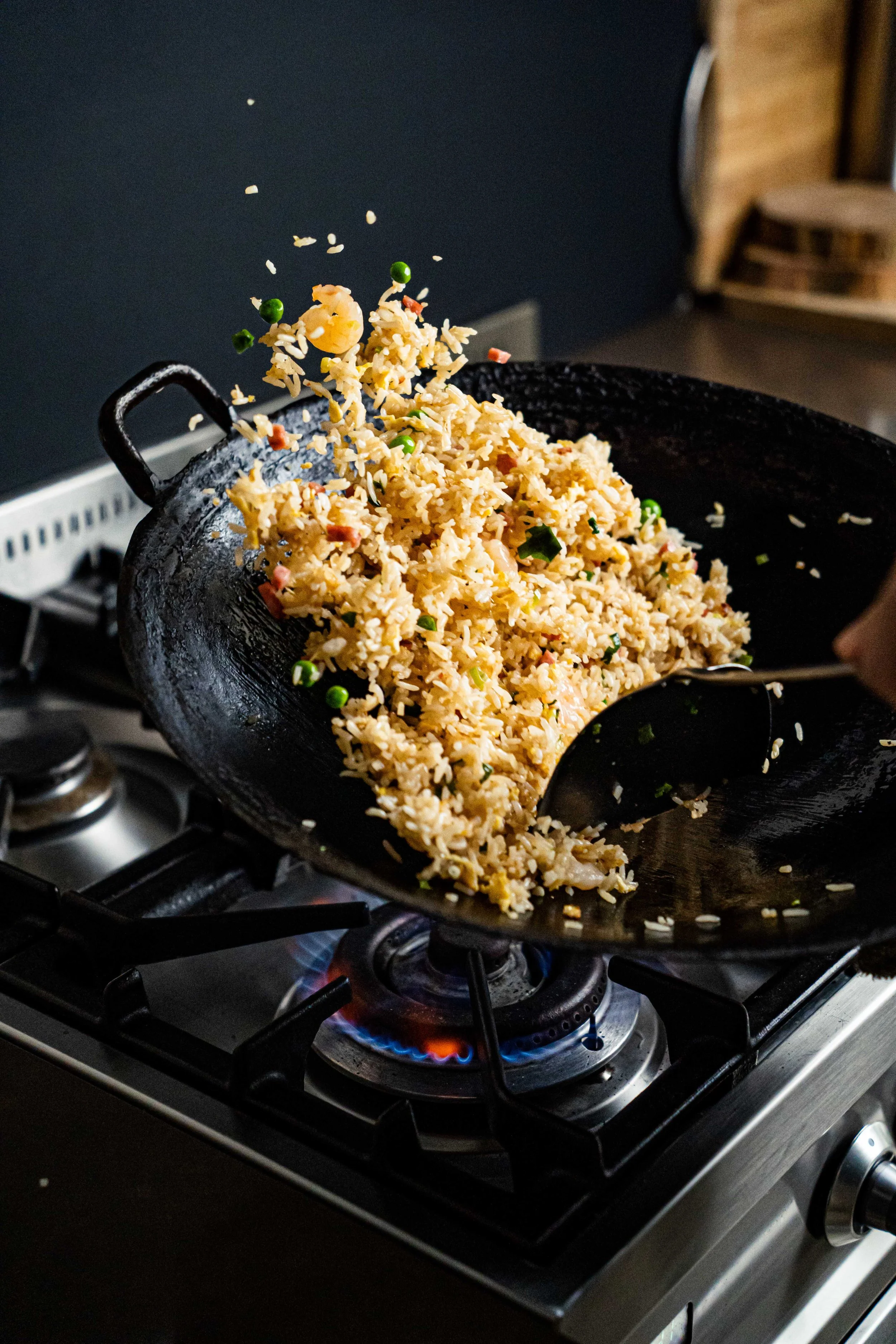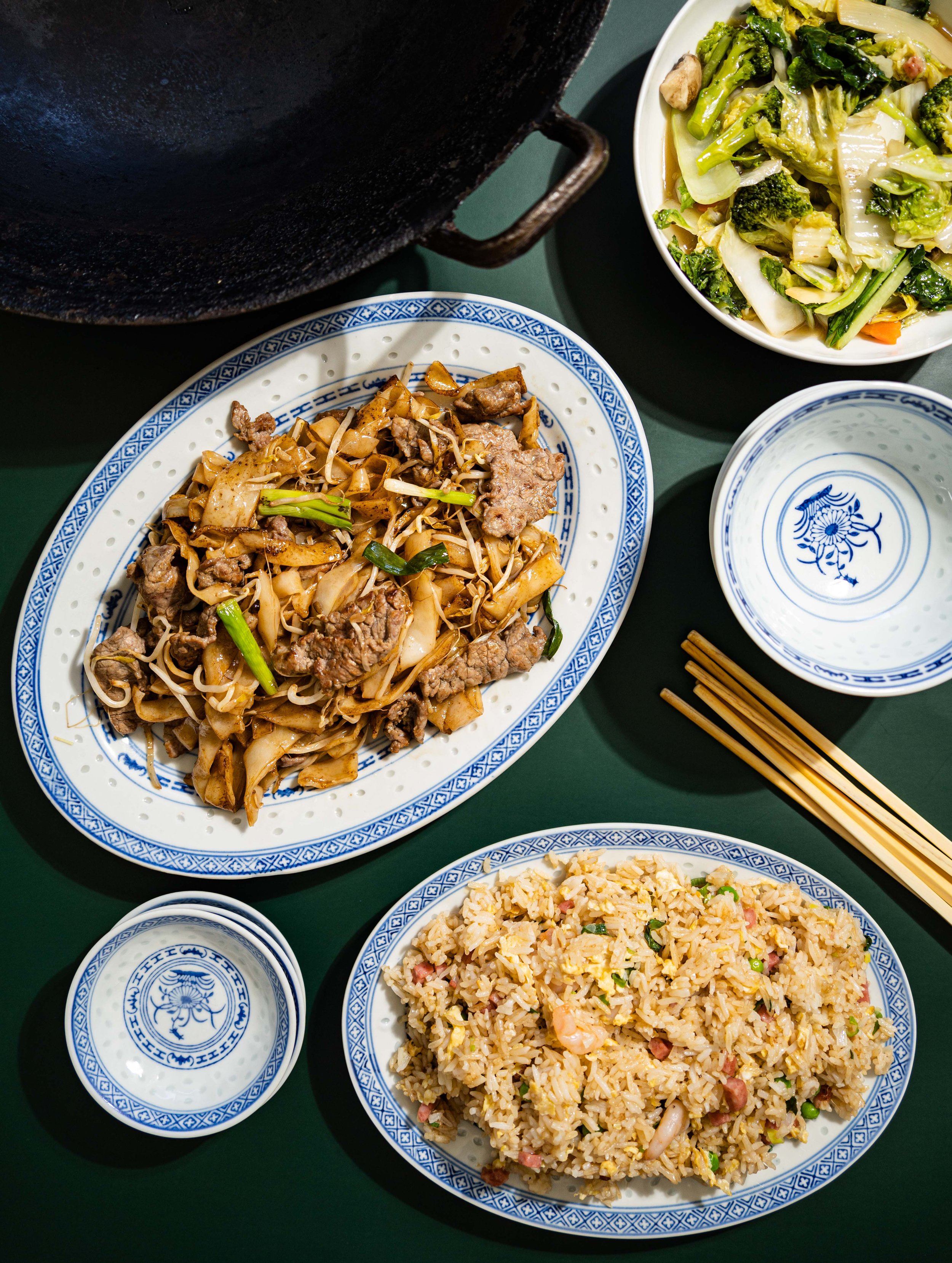Wok Hei: A Smoky Breath of Air
Image description: Fried rice lifts off the side of a black wok in the air, the wok is placed over the burner on a stove. Photograph: Brian Tam
Words by Brian Tam.
I /
There’s an eager silence around our table as the waiter approaches. The large, shallow plate he’s cradling is topped with gon chow ngau ho – the classic Cantonese dish of flat rice noodles, stir-fried with tender beef strips, bean sprouts and spring onions. He sets the plate down and Mum loads up our bowls; our hungry eyes darting between each one to see which is piled the highest.
Image description: Brian’s mother holds a spatula in a black wok which sits over the flame on a burner in her kitchen. Photograph: Brian Tam
We take a mouthful, then look at each other and nod as Dad delivers the ultimate compliment: “Mmm. Good wok hei.”
II /
Before we dive into the world of wok hei, it’s worth covering some of the fundamentals of Cantonese cuisine.
Despite what the ‘sweet and sour’ or ‘black bean’ sections of your local Chinese restaurant’s menu would have you believe, Cantonese dishes are characterised not so much by the addition of flavours, but by the cooking methods used to prepare them.
That’s not to say taste isn’t important though - the cuisine values freshness of ingredients and clean flavours, so the cooking method for each dish is designed to preserve and showcase the natural flavours of its ingredients.
Many of these methods are – not unlike a Mozart sonata – gentle and delicate in nature: softly poaching a chicken to pair with a ginger shallot sauce for bak chit gai (white cut chicken), patiently braising chunks of beef brisket, tendon and daikon for ngau lam mein (beef brisket noodles), or steaming a rissole of hand-minced pork and preserved vegetables for ju yook bang (pork patty).
At the other end of the technique spectrum – with the intensity and power of a Tchaikovsky symphony – is stir frying. One of the cornerstones of Cantonese cooking, it’s an assault on the senses – the heat radiating from the stove, the sizzling of raw ingredients as they collide with hot oil, the unmistakable scraping of the steel spatula against the wok as it propels ingredients into the air.
Despite stir frying being ubiquitous across Hong Kong’s restaurants, dai pai dongs (food stalls) and home kitchens, true mastery of it is less common and hinges on being able to achieve one key element: wok hei.
Image description: A black wok sits in the top left, stir-fried vegetables in the top right in a bowl, gon chow ngau ho in the middle and fried rice on a long plate at the bottom with little bowls and chopsticks next to it. Photograph: Brian Tam
III /
The culinary lexicon tends to be fairly literal. Sous vide? Under vacuum. Al dente? To the tooth.
Wok hei, however, breaks this convention. Taking a more ethereal approach, its direct translation is ‘breath of the wok’, referring to the ferocious energy within the wok that gives dishes a complex, charred flavour and an intoxicatingly smoky aroma. It’s responsible – more so than the misunderstood MSG – for that often indescribable difference between a middling fried rice and one that’s uncontrollably moreish; between a ho-hum side of gai lan (Chinese broccoli) and one that commands centre stage.
Many have embarked on the quest to uncover the exact science behind wok hei, and as food writer Lan Lam sums up, most experts attribute it to three main factors: the aroma compounds that are created with searingly hot oil, the chemical interactions between the food and the wok’s surface, and the ultra-fast browning and caramelisation that takes place (otherwise known as the Maillard reaction).
In practice, this means wok hei relies on having a well-seasoned wok (preferably carbon steel or cast iron), coupled with the firepower of a commercial wok burner. The rest is all about timing and technique: adding the oil and ingredients at the right time, the continuous ‘wok tossing’ motion to control the level of heat and moisture, and cooking the ingredients just long enough to impart that signature wok flavour while also retaining their texture.
“Much like a breath itself, a dish’s wok hei is fleeting, so as soon as it’s set down on the table, it’s best to drop everything and dive in.”
Image description: A close-up of a black wok on the right and a plate of fried rice to the left and little blue and white porcelain bowls above it. Photograph: Brian Tam
Once the food is transferred from wok to plate, the heavy lifting is done, but there’s still an important role for the diner to play. Much like a breath itself, a dish’s wok hei is fleeting, so as soon as it’s set down on the table, it’s best to drop everything and dive in.
IV/
Growing up, cooking was always something that I was drawn to and I loved watching as my parents prepared meals. I could stare at cooking shows for hours on end (even if it was only Ready Steady Cook and a young Jamie Oliver back then), and always came away from cooking classes with a smile (as well as a second lunch).
By the time I moved out of home, I felt like I knew my way around the kitchen enough to not have to rely on takeaway pizzas and instant noodles. But there was one issue: try as I might, I just couldn’t recreate the dishes Mum and Dad had made throughout all those years at home.
After a while, it dawned on me that it wasn’t down to whether I’d bought Lee Kum Kee or Kikkoman soy sauce, or whether I’d velveted (tenderised) the meat with bicarb soda for long enough. No, it was a gear issue (or lack thereof): in the battle of cookware, my featherlight non-stick frypan and electric hob combo was no match for our family wok and the gas flame powering it.
With that realisation came an immediate, newfound appreciation for that wok. That wok, which came over to Australia with my parents and I when we left Hong Kong in 1988. That wok, which we had used so often it just sat on top of the stove and never had its own spot in the cupboard. That wok, which had the versatility of a Swiss army knife and wasn’t just used for stir-frying, but for blanching, steaming, deep frying, braising and even scrambling the silkiest of eggs.
Even now, I feel a great amount of joy when I get the chance to cook with our wok. It isn’t just because of the wonderful non-stick patina that has developed on it over the last three decades, or the fact it still outperforms every pan in my cupboard. Rather, it’s the memories of growing up with it – being in awe of its power, even when I was too short to be able to see inside it; introducing school friends to new foods when they came over for dinner; and knowing that it’s provided our family with over 35 years of meals, in good times and bad.
Indeed, there’s a unique sense of family and cultural connection baked into that wok’s black, craggly surface - something that even wok hei can’t provide.




